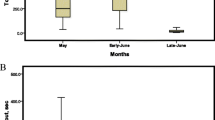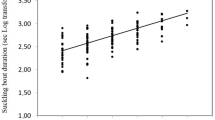Abstract
Mother–offspring interactions soon after parturition play a key role in the survival of mammals. We investigated the suckling behavior of semi-captive Western Derby eland (Taurotragus derbianus derbianus) in a 60-ha enclosure covered by dense savanna vegetation in Senegal and farmed Common eland (T. oryx) on an open 2-ha pasture in the Czech Republic. We hypothesized that the basic pattern of suckling bout duration and mother–offspring interactions would be similar between species, but would vary in response to the environmental conditions and breeding system. During three calving periods, we observed the suckling of 27 and 23 calves of Derby and Common elands, respectively, between the ages of 1–5 months, and the interactions between mother and calf before and during suckling. Suckling bout duration increased with the age of the calves for both elands. However, in Derby elands we recorded longer suckling bouts in male than female calves and shorter suckling bouts in primiparous mothers than multiparous ones; no differences were found in farmed Common elands. The animals’ active approach to mother–offspring contact, for example naso–anal contact, and initiation and termination of suckling, resulted in longer suckling bouts in Derby elands. The results suggest that Derby elands that range over a large enclosure with dense vegetation cover adjust their maternal behavior in compliance with potential predator risk, facing a trade-off between nursing and vigilant behavior in the wild. The suckling behavior of farmed elands, on the other hand, reflects the conditions of captivity without predators and with the small available area enabling permanent visual contact of animals.





Similar content being viewed by others
References
Altmann J (1974) Observational study of behaviour: sampling methods. Behaviour 49:227–267
Andersen R, Gaillard JM, Linnel JDC, Duncan P (2000) Factors affecting maternal care in an income breeder, the European roe deer. J Anim Ecol 69:672–682
Antonínová M, Hejcmanová P, Verner PH, Koláčková K (2008) African Studbook: Western giant eland (Taurotragus derbianus derbianus (Gray, 1847)), 1st edn. Czech University of Life Sciences, Prague
Blumstein DT, Daniel JC (2005) The loss of anti-predator behaviour following isolation on islands. Proc R Soc B 272:1663–1668
Bongi P, Ciuti S, Grignolio S, Del Frate M, Simi S, Gandelli D, Apollonio M (2008) Anti-predator behaviour, space use and habitat selection in female roe deer during the fawning season in a wolf area. J Zool 276:242–251
Bowyer RT, van Ballenberghe V, Kie JG, Maier JAK (1999) Birth-site selection by Alaskan moose: maternal strategies for coping with a risky environment. J Mammal 80:1070–1083
Braza F, San José C, Aragón S (2000) Variation of male-biased maternal investment in fallow deer (Dama dama). J Zool 250:237–241
Byers JA, Byers KZ (1983) Do pronghorn mothers reveal the locations of their hidden fawns? Behav Ecol Sociobiol 13:147–156
Cameron EZ, Linklater WL, Stafford KJ, Minot EO (2000) Aging and improving reproductive success in horses: declining residual reproductive value or just older and wiser? Behav Ecol Sociobiol 47:243–249
Caro TM, Graham CM, Stoner CJ, Vargas JK (2004) Adaptive significance of antipredator behaviour in artiodactyls. Anim Behav 67:205–228
Cassinello J (1996) High-ranking females bias their investment in favour of male calves in captive Ammotragus lervia. Behav Ecol Sociobiol 38:417–424
Cassinello J (2001) Offspring grazing and suckling rates in a sexually dimorphic ungulate with biased maternal investment (Ammotragus lervia). Ethology 107:173–182
Ciuti S, Bongi P, Vassale S, Apollonio M (2006) Influence of fawning on the spatial behaviour and habitat selection of female fallow deer (Dama dama) during late pregnancy and early lactation. J Zool 268:97–107
Clutton-Brock TH (1991) The evolution of parental care. Princeton University Press, New Jersey
Cowan IM (1974) Management implications of behaviour in the large herbivorous mammals. In: Geist V, Walther F (eds) The behaviour of ungulates and its relation to management. International Union for the Conservation of Nature, Switzerland, pp 921–934
Drábková J, Bartošová J, Bartoš L, Kotrba R, Pluháček J, Švecová L, Dušek A, Kott T (2008) Sucking and allosucking duration in farmed red deer (Cervus elaphus). Appl Anim Behav Sci 113:215–223
Ekvall K (1998) Effects of social organization, age and aggressive behaviour on allosuckling in wild fallow deer. Anim Behav 56:695–703
Estes RD (1992) Behaviour guide of African mammals: including hoofed mammals, carnivores, primates. University of California Press, Berkeley
Festa-Bianchet M, Jorgenson JT (1998) Selfish mothers: reproductive expenditure and resource availability in bighorn ewes. Behav Ecol 9:144–150
Gaillard JM, Festa-Bianchet M, Yoccoz NG, Loison A, Toïgo C (2000) Temporal variation in fitness components and population dynamics of large herbivores. Annu Rev Ecol Syst 31:367–393
Green WCH (1990) Reproductive effort and associated costs in Bison bison: do older mothers try harder? Behav Ecol 1:148–160
Green WCH, Rothstein A (1991) Sex bias or equal opportunity? Patterns of maternal investment in bison. Behav Ecol Sociobiol 29:373–384
Hamel S, Côté SD (2008) Trade-offs in activity budget in an alpine ungulate: contrasting lactating and non-lactating females. Anim Behav 75:217–227
Hejcmanová P, Hejcman M, Camara AA, Antonínová M (2010a) Exclusion of livestock grazing and wood collection in dryland savanna: an effect on long-term vegetation succession. Afr J Ecol 48:408–417
Hejcmanová P, Homolka M, Antonínová M, Hejcman M, Podhájecká V (2010b) Diet composition of Western Derby eland (Taurotragus derbianus derbianus) in a natural and a managed habitat in Senegal using faeces analyses. South Afr J Wild Res 40:27–34
Hnida JA (1985) Mother–infant and infant–infant interactions in captive sable antelope: evidence for behavioural plasticity in a hider species. Zoo Biol 4:339–349
IUCN (2010) IUCN SSC Antelope Specialist Group 2010. Tragelaphus derbianus. 2010 IUCN red list of threatened species. http://www.iucnredlist.org. Downloaded on 10 July 2010
Jarnemo A (2004) Predation processes: behavioural interactions between red fox and roe deer during the fawning season. J Ethol 22:167–173
Kingdon J (1982) East African mammals, Vol. III. Part C, D (bovids). Academic Press, London
Kohlmann SG, Müller DM, Alkon PU (1996) Antipredator constraints on lactating Nubian ibexes. J Mammal 77:1122–1131
Lent PC (1974) Mother–infant relations in ungulates. In: Geist V, Walther F (eds) The behaviour of ungulates and its relation to management. International Union for the Conservation of Nature, Switzerland, pp 14–54
Leuthold W (1977) African ungulates: a comparative review of their ethology and behavioural ecology. Springer, New York
Magurran AE (1999) The causes and consequences of geographic variation in antipredator behaviour: perspectives from fish populations. In: Foster SA, Endler JA (eds) Geographic variation in behaviour: perspectives on evolutionary mechanisms. Oxford University Press, New York, pp 139–163
Manski DA (1991) Reproductive behaviour of addax antelope. Appl Anim Behav Sci 29:39–66
Murdock GK, Stine WW, Maple TL (1983) Observation of maternal–infant interactions in a captive herd of Sable antelopes (Hippotragus niger). Zoo Biol 2:215–224
Nežerková P, Verner PH, Antonínová M (2004) The conservation programme of the Western giant eland (Taurotragus derbianus derbianus Gray 1847) in Senegal—Czech Aid Development Project. Gazella 31:87–182
Nowak R, Porter RH, Lévy F, Orgeur P, Schaal B (2000) Role of mother–young interactions in the survival of offspring in domestic animals. Rev Reprod 5:153–163
Oftedal OT (1985) Pregnancy and lactation. In: Hudson RJ, White RG (eds) Bioenergetics of wild herbivores. CRC Press, Boca Raton, pp 215–238
Ozoga JJ, Verme LJ (1986) Relation of maternal age to fawn-rearing success in white-tailed deer. J Wildl Manag 50:480–486
Packer C, Lewis S, Pusey A (1992) A comparative analysis of non-offspring nursing. Anim Behav 43:265–281
Panzacchi M, Linnell JDC, Odden M, Odden J, Andersen R (2009) Habitat and roe deer fawn vulnerability to red fox predation. J Anim Ecol. doi:10.1111/j.1365-2656.2009.01584.x
Pappas LA (2002) Taurotragus oryx. Mammal Species 689:1–5
Pélabon C, Yoccoz NG, Ropertcoudert Y, Caron M, Peirera V (1998) Suckling and allosuckling in captive fallow deer (Dama dama, Cervidae). Ethology 104:75–86
Rachlow JL, Bowyer RT (1998) Habitat selection by Dall’s sheep (Ovis dalli): maternal trade-offs. J Zool 245:457–465
Ralls K, Kranz K, Lundringan B (1986) Mother–young relationships in captive ungulates: variability and clustering. Anim Behav 34:134–145
Robbins ChT, Podbielancik-Norman RS, Wilson DL, Mould ED (1981) Growth and nutrient consumption of elk calves compared to other ungulate species. J Wildl Manag 45:172–186
Rognmo A, Markussen KA, Jacobsen E, Grav HJ, Blix AS (1983) Effects of improved nutrition in pregnant reindeer on milk quality, calf birth weight, growth, and mortality. Rangifer 3:10–18
Roulin A (2002) Why do lactating females nurse alien offspring? A review of hypotheses and empirical evidence. Anim Behav 63:201–208
Rubeš J, Kubíčková S, Pajacova E, Černohorská H, Di Berardino D, Antonínová M, Váhala J, Robinson TJ (2008) Phylogenomic study of spiral-horned antelope by cross-species chromosome painting. Chromosom Res 16:935–947
Rubin ES, Michelson KJ (1994) Nursing behaviour in dam-reared Russian saiga (Saiga tatarica tatarica) at the San Diego Wild Animal Park. Zoo Biol 13:309–314
Sarno RJ, Franklin WL (1999) Maternal expenditure in the polygynous and monomorphic guanaco: suckling behaviour, reproductive effort, yearly variation, and influence on juvenile survival. Behav Ecol 10:41–47
Therrien JF, Côté SD, Festa-Bianchet M, Ouellet JP (2007) Conservative maternal care in an iteroparous mammal: a resource allocation experiment. Behav Ecol Sociobiol 62:193–199
Therrien JF, Côté SD, Festa-Bianchet M, Ouellet JP (2008) Maternal care in white-tailed deer: trade-off between maintenance and reproduction under food restriction. Anim Behav 75:235–243
Thompson K (1996) Maternal strategies in Sable antelope, Hippotragus niger: factors affecting variability in maternal retrieval of hiding calves. Zoo Biol 15:555–564
Toïgo C (1999) Vigilance behaviour in lactating female Alpine ibex. Can J Zool 77:1060–1063
Verme LJ (1989) Maternal investment in white-tailed deer. J Mammal 70:438–442
Víchová J, Bartoš L (2005) Allosuckling in cattle: gain or compensation? Appl Anim Behav Sci 94:223–235
Wallington PB, McKechnie AE, Owen-Smith N, Woodborne S (2007) Stable carbon isotope analysis of eland (Taurotragus oryx) diet in the Suikerbosrand Nature Reserve. S Afr J Wildl Res 37:127–131
White KS, Berger J (2001) Antipredator strategies of Alaskan moose: are maternal trade-offs influences by offspring activity? Can J Zool 79:2055–2062
Wilson DE, Hirst SM (1977) Ecology and factors limiting Roan and Sable antelope populations in South Africa. Wildl Monogr 54:1–111
Wronski T, Apio A, Wanker R, Plath M (2006) Behavioural repertoire of the bushbuck (Tragelaphus scriptus): agonistic interactions, mating behaviour and parent–offspring relations. J Ethol 24:247–260
Zapata B, González BA, Ebensperger LA (2009) Allonursing in captive Guanacos, Lama guanicoe: milk theft or misdirected parental care? Ethology 115:731–737
Acknowledgments
We are highly indebted to the Society for the Protection of Environment and Fauna in Senegal, namely to director managers Georges Rezk and Christian Dering and their staff of the Western Derby eland conservation programme. We are also grateful to Radim Kotrba for his incentive comments and professional management of Common eland breeding management at the University Farm Lány. We are grateful to Nada Al Hakimová and Hana Zemanová to their assistance with data collection. The study was supported by Grant Agency of Academy of Sciences of the Czech Republic, the grant number IAA 6023404.
Author information
Authors and Affiliations
Corresponding author
About this article
Cite this article
Hejcmanová, P., Vymyslická, P., Koláčková, K. et al. Suckling behavior of eland antelopes (Taurotragus spp.) under semi-captive and farm conditions. J Ethol 29, 161–168 (2011). https://doi.org/10.1007/s10164-010-0241-1
Received:
Accepted:
Published:
Issue Date:
DOI: https://doi.org/10.1007/s10164-010-0241-1




